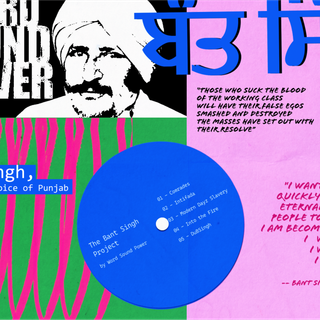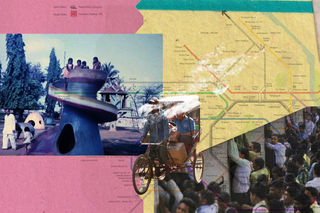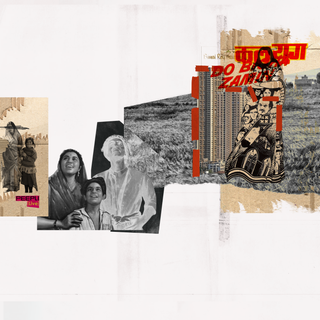
The Utopia of the Livable City
Zohran Mamdani's mayoral campaign in New York City revives the idea of a city built for people over corporations.

A majority of the world’s population lives in cities; they are the driving forces of capital and politics. It is futile to try and predict or explain one, which makes the reels mediating exotic city life to out-of-towners rather two-dimensional. Only literature is up to the task of describing a city and the results are often sensuous and thrilling as they are bleak and nihilistic. There are pulsating nightclubs for an upwardly mobile generation situated in water-scarce neighbourhoods; the acrid aftertaste of construction dust outside a quiet public library; ecstatic fans at a movie theatre celebrating a movie star even as they return to segregated locales. These contradictions exist because of two clashing visions for what a city should be like: one that says it should be a jungle of brutalist architecture emphasizing a profit-based economic vision, another that says it should represent the teeming life of its inhabitants by way of expanding the commons that are of value to everybody.
Zohran Mamdani’s mayoral race has meant many things to many people all over the world. The heart of the Mamdani campaign isn’t so much about Mamdani’s own tastes, background, personality or likeability, as politics is so often reduced to. It’s about “the flourishing of city life,” as Mamdani said in an interview with David Remnick, and how the powers that be undermine that as an affront to their political agenda. As we watch the historic outcome play out from India, there is a tendency to celebrate the person and the identity – to “lib out” as the terminally online say – but underlying the election of hope is the promise of a livable, walkable, breathable city finally becoming a prospect against the naysaying of corporate elites. It’s worth noting that Mamdani didn’t promise much – just free buses, childcare, lower rents and more grocery stores, for the most part. But it’s the rhetoric of hope for a better city that makes this election reverberate across the world, in regions where that hope has been diminished against the onslaught of corporate capture and climate ruin.
At the time of writing this, Delhi residents are being advised to leave the city for five to six weeks if they can afford to; those who remain report burning eyes, tongue blisters and choked airways. In Mumbai, a city that textbooks used to call the “Manhattan of the East,” neighbourhoods continue to be gentrified at a mass scale – see, for instance Adani’s Dharavi Redevelopment project, which threatens the homes and livelihoods of tens of thousands of Mumbai residents, or the Coastal Road Project that displaced the Koli people, Mumbai’s original inhabitants. We are now looking at the potential destruction of a significant part of the Sanjay Gandhi National Park in favour of the BMC’s Draft Zonal Master Plan, which aims to promote “eco-tourism” and boost economic growth. A study in Nature published this week showed that Chennai, Mumbai and Delhi are staring at a future of land sinking, thanks to the over-exploitation of ground-water. As the 2018 Thoothukudi massacre has shown, protesting private companies’ industrial projects can be fatal – states increasingly work to protect corporate interests over that of citizens.
India Wants to Build Smart Cities. We Asked Experts if These Urban Designs Can Survive the Climate Crisis.
Beyond specific projects and urban development behemoths, we’ve known and felt for a while that the big cities, once full of promise and hope, are getting more viscerally unlivable. It is par for the course that a handful of people be killed every other day by a collapsing billboard, a caved-in road, an electrical wire, a hospital fire, a train derailment, a capsized bus, a speeding vehicle (where there would normally be a pavement), an oxygen shortage, a construction mishap, an exploding air conditioner, water stagnation causing a dengue epidemic, a pothole, a heatstroke, hunger, sewage contamination. Medieval diseases that ought to have been eradicated continue to abound – cholera, tuberculosis, hepatitis and even rabies collectively wipe out millions annually in India. Most colleges and hospitals are now privately owned. Transport is mediated through private ride-hailing companies. All three are prohibitively expensive as a result. Real estate prices go up to several lakhs per square foot in most Indian metro cities. Rent-controlled housing has crumbled into disrepair. Just two years ago, a financial suburb of Mumbai was shut down for a billionaire’s wedding. The Hiranandani complexes of Powai were built on the ruined homes of Jai Bhim Nagar’s residents, who still have nowhere to go. All this takes place against the express wishes of voters. We’ve lost the imagination to even hope for anything better, even if we once knew better. So when the Mamdani campaign promised to resist the oligarchs, it was a de-facto call to action for all cities in the world.
“The fast-paced growth of the Indian economy and particularly its cities has produced an urban crisis, one that is marked by the lack of adequate infrastructure and growth management as well as by sharp social divisions that are starkly etched in a landscape of bourgeois enclaves and slums,” noted urban development scholar Ananya Roy. For a brief moment in young people’s lives, undergraduate courses on built environment might be the only source of knowledge to radicalise them by introducing the idea of the right to the city. Henri Lefebvre, a French philosopher, posited that our living spaces shouldn’t be overrun by the interests of commercialism and capitalism, and that people living in it should be able to govern and shape the space according to their own social and cultural interests. Remarkably, The Delhi High Court invoked the right to the city when it delivered its judgement in a case where residents of a slum petitioned against the demolition of their homes; the Court argued that slum-dwellers aren’t “encroachers” as city administrators often view them, but people who are actively involved in the growth of the city and who have an equal right to access its infrastructure and space. But this is a view that is exceptional, rather than the norm. The right to the city as a concept feels utopian because it’s relegated to the realm of the liberal arts and the United Nations, both frequently deemed unrealistic in a world run by hard neoliberal economics.
Indeed, cities are increasingly fragmented by pockets of enclosed private spaces: the rise of gated communities, as urban development scholars noted, divides cities by wealth and capital over public interest. The commons – lakes, forested enclaves, wetlands – are captured by big real estate to build Elysian cocoons for the few, sacrificing the interests of the many. But this is bad even for the few. The water bodies and the forests don’t discriminate when it comes to protecting the ecological balance, that includes us. We see the results of it already in highrise homes that suffer from polluted air as much as any others. Jane Jacobs, in The Life and Death of Great American Cities, wrote that “so many people want to live in [a specific] locality that it becomes profitable to build, in excessive and devastating quantities, for those who can pay the most. Families are crowded out. Variety of scene is crowded out.” Indeed, gated communities regularly construct separate entrances and lifts for the working class. Privately owned establishments continue to put up signs restricting access to “drivers” and “ayahs.” In Indian cities, living with each other as equals is increasingly structurally impossible. This is unjust, but it also atrophies the soul. Which perhaps explains the soullessness of the various dining establishments mushrooming in gentrified city borough, which all look the same and cater to an amorphous idea of a placeless, nationless, global citizen.
How the Design of Our Cities Reflects Caste, Class Anxieties
What would a city look like if all its inhabitants were valued? This is why perhaps the most moving aspect of Mamdani’s campaign is its focus on children and their care – a goal that encompasses the worldwide struggle to make our surroundings better and safer. The American historian Lewis Mumford, who said that the primary function of the city is to “convert power into form, energy into culture, dead matter into the living symbols of art, biological reproduction into social creativity,” also said: “Every new baby is a blind desperate vote for survival: people who find themselves unable to register an effective political protest against extermination do so by a biological act.” Nearly every Indian city contains hundreds and thousands of children forced to sell wares on the streets, or who are carried by malnourished or disabled mothers begging in traffic junctions – children whose prospects of survival in the city are bleak because the city does not consider them to be future people.
Beyond the famously romanticized metropolises of India, however, lie the forgotten ones. In the upcoming Bihar elections, a major focal point is the ruling party’s promise to “develop” Patna by way of airports, highways, and infrastructure projects that could turn the city into a global one to be reckoned with. The opposition bloc is, for its part, running on a welfare campaign; promising jobs for every family and a universal basic income for women. Once again we find a civilizational clash: can cities be constructed with concrete, or does it grow around people who have the means to participate in city life? The urge to develop what was once a great medieval and later colonial capital city into something resembling a different city stems, ultimately, from the limited notion that “urban” is an aesthetic category rather than a political and social one. No amount of glass skyscrapers can help human beings if a majority of them cannot afford to live inside. But our political rhetoric – excluding the poor, the migrants and the religious and caste minorities – show that perhaps the glass skyscrapers exist because of the people who can’t live inside; their purpose is to exclude. Sanjay Srivastava’s idea of “entangled urbanism” suggests as much: that cities are formed out of the messy intertwinements between seemingly opposing entities. That makes a political campaign like Mamdani’s that much more illuminating: while his opponents attempted to discredit his welfare policies by pointing out his privileges, the point is that it all coexists. Fulfilling human needs like housing, food security and mental health only helps us decide for ourselves how we want our cities to live and breathe around and alongside ourselves.
Mayors don’t have Constitutional powers in India, so we are excused for not knowing the names of our city mayors. But this moment was never about a person – Zohran Mamdani, as every politician, is accountable to his electorate for the policy promises he has made about New York as a city. But this moment in time is a reminder of the vision beyond the policies: free buses help us meet loved ones and make friends; lower rents help us make art and dream about life without the anxiety of not having a roof; child care helps us imagine a livable future where the young can grow up as they deserve to. And for all its faults, there are many things that New York shares with our great Indian cities, as well as all cities over the world: the possibility of a better future, a better life, and a better community. Politicians build their careers on constantly reminding us of the threats breaching our city borders – always articulated in the form of unwanted people – and they win on the basis of fear of the other, leaving the fate of cities we do live in by the wayside. But we all, insiders and outsiders at once, deserve the romance of a living space that allows us to thrive because of others, not at their expense – and this is the city worth fighting for everywhere. We are not asking for much: just a sensory landscape of a city that’s filled with children’s laughter, music, prayer calls, protest, balmy temperatures, clean air and birdsong.
Rohitha Naraharisetty is a Senior Associate Editor at The Swaddle. She writes about the intersection of gender, caste, social movements, and pop culture. She can be found on Instagram at @rohitha_97 or on Twitter at @romimacaronii.
Related


We're Reading Arundhati Roy Badly
